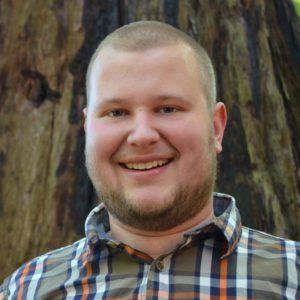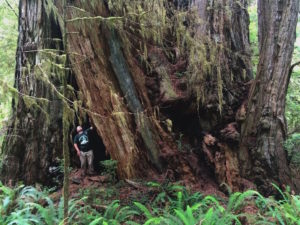 Decades before Zane Moore was born, his grandfather planted a redwood tree in the backyard of his San Jose, California home. Moore spent his childhood looking up at that tree and hiking through redwood forests in the mountains nearby. After years of gazing up in awe at one of the largest living things in the world, Moore now spends his time looking down through a microscope at one of their smallest components – their cells.
Decades before Zane Moore was born, his grandfather planted a redwood tree in the backyard of his San Jose, California home. Moore spent his childhood looking up at that tree and hiking through redwood forests in the mountains nearby. After years of gazing up in awe at one of the largest living things in the world, Moore now spends his time looking down through a microscope at one of their smallest components – their cells.
Moore graduated from Colorado State University in 2016 with a Bachelor’s of Science in Botany from the Department of Biology in the College of Natural Sciences. He is now in a plant biology Ph.D. program at the University of California, Davis, where he is studying redwood genetic mutations and helping to sequence the redwood genome.
He is interested in redwood genetic mutations for two reasons. First, redwoods can live for more than 2,000 years and accumulate mutations over their entire lifespan. Second, redwoods typically reproduce by cloning themselves, meaning that mutations are passed onto the next generation. Together, this means that an individual redwood may contain hundreds of thousands of years’ worth of harmful mutations.
“Basically, the fundamental biological question that we know nothing about is, how do old-lived organisms deal with mutational load?” Moore said. “How do they accumulate all these mutations without dying?”
Recent advances in DNA sequencing technology have made this project possible; even five years ago it would have been impossible to sequence the redwood genome, due to technological and financial constraints of genetic sequencing. Moore is excited to explore basic aspects of this little-understood organism.
“Whatever I find, it’s going to be a discovery,” he said.
Mutation accumulation
In a living redwood, just as the oldest branches are near the bottom of a tree and the youngest are near the top, the oldest genetic mutations are located near the bottom of the tree, and the newest mutations are at the top. Moore compares it to an evolutionary tree that shows the relationship between different species. But with a redwood, that plays out on a single tree.
“As the tree grows, literally an evolutionary tree is being built by the actual tree,” he said.
But before he can study how much of its DNA contains mutations, the redwood genome had to be sequenced by the team in the Neale Lab at UC Davis, which includes Moore. The work is funded by the Save the Redwoods League, a nonprofit redwood conservation organization. It’s a project that comes with some unique challenges.
For example, the redwood’s genome contains 32 billion base pairs of DNA. That’s ten times more than the human genome, and it would be 65 feet long if laid out on a table, Moore said. There are also six copies of each chromosome, compared to the typical two in human DNA. To add further complication, the team at UC Davis has been sequencing each genome 100 times to make sure they have every piece of the puzzle.
“This is going to be the largest genome ever sequenced, and it’s probably going to be the most complex,” Moore said.
The sequencing work at UC Davis was completed this year, and now the process moves to Johns Hopkins University, where the genome will be assembled in the correct order. It’s essentially like putting the pieces of a puzzle together, Moore said, and should take another year. After that, he can start looking at where the mutations occur in the DNA. But until then, Moore is studying redwood cell divisions to determine how many cells divide over the course of the tree’s life – “probably many million,” he said.
Fort Collins roots
Moore said that the skills he learned at CSU have helped him in this project. For example, Moore learned about plant anatomy and morphology techniques from David Steingraeber, an associate professor in the Department of Biology. As Steingraeber’s student, Moore also studied the rare Mimulus gemmiparus, or Rocky Mountain monkeyflower, which reproduces clonally like the redwood. He said it’s one of the reasons he became interested in redwood mutations.
As an undergraduate, Moore was awarded the College of Natural Sciences’ Marilyn and Ron Tuttle Undergraduate Research Scholarship. The scholarship was established by CSU biology and botany alumna Marilyn Tuttle and her husband Ron and provides support to biochemistry and biology undergraduates to conduct research.
Moore credits this scholarship with allowing him to pursue his own research on redwoods, which no one else at CSU was doing. Some of that work was featured in stories by National Geographic, NPR and theWashington Post.
When he graduates from UC Davis, Moore plans to keep studying other long-lived trees, such as the bristlecone pine, which can live for more than 5,000 years. Moore said that he is fascinated by how these trees deal with such a long lifespan.
“The older a tree gets, the more it gets beat up, just smashed by life,” he said. “Yet they can persist through that. I love that about it because it shows life’s resilience.”

